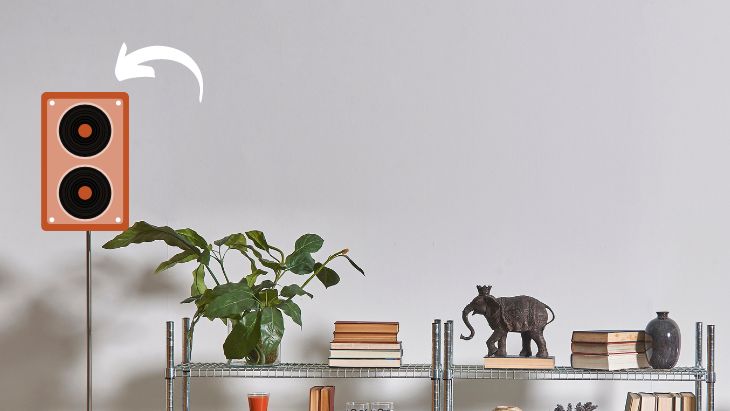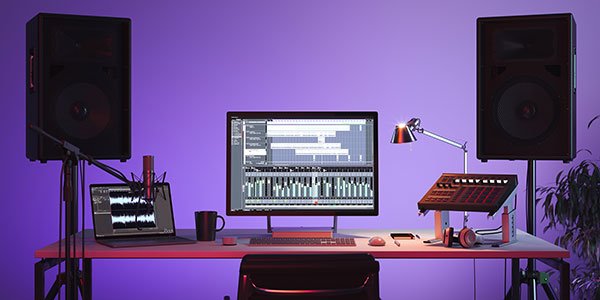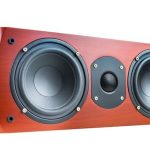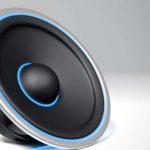Speaker location is probably one of the most important factors when it comes to sound quality. Bookshelf speakers are designed to rest on a shelf or any other elevated surface and they are specifically made to reproduce sound in a small-to-medium-sized room. They are small enough to fit on a bookshelf, and usually, they are two-way speakers with a bass driver and a tweeter. However, some are substantially larger.
However, just because they are called bookshelf speakers doesn’t mean you have to place them on a bookshelf. You can still put them on the shelf, but taking your speakers off the shelves will help improve their performance significantly and make them sound way better. Speaker stands are designed to ensure optimal speaker performance, and getting a good pair of speaker stands for your bookshelf can make a big difference.
Also, from a décor standpoint, it is important to point out that bookshelf speakers on a stand tend to take less space than tower/ floor standing speakers with a similar footprint. Also, most speaker stands come with inbuilt cable management to hide the wires. This will come in handy when you are using bookshelf speakers as surround speakers, and you want to have a neat appearance.
Reasons why bookshelf speakers sound better on Stands
i. Excellent sound Requires proper Speaker positioning

Placing bookshelf speakers on stands allows you to position them where they will sound excellent. Also, it will enable you to position them at the same distance from each other and the listening position, thus creating a “sweet spot.” Besides, putting speakers on stands creates a real stage or studio for the music playing and also helps you pinpoint where each voice and instrument is coming from.
Also, with a dedicated speaker stand, you will be able to experience tightening of the bass and improve overall image stability. The stand also makes it easy to align the speakers’ axes horizontally, thus creating a more accurate soundstage. And with a good subwoofer, the speakers can deliver sound pretty close to what you get from larger floor-standing speakers.
ii. Minimal reflections for a much clearer sound
When you are watching a movie or listening to music, you’ll not just hear the sound coming directly from your speakers only. Instead, you’ll also hear reflected sounds from the walls, shelves, and other surfaces, and this can distort the sound image and affect the sound quality to a great extent.
Taking your speakers off the shelves will help keep these reflections to a minimum, enabling you to hear more direct sound from your speakers. This is the reason why it is recommended to get your speakers away from corners and walls.
Also, the added distance between your speakers and surfaces is vital for the speakers’ low-end performance. The low-frequency range is somehow all-directional, and it tends to be more sensitive to surfaces than the high-frequency spectrum. Thus, stands will provide the optimal conditions for your speakers to be their best.
Using a bookcase for your speakers is also not advisable, mainly because the shelves themselves can vibrate. This is particularly crucial if your other audio components such as turntables on the same shelf are greatly affected by the vibrations.
iii. Speaker stands to allow you to have tweeters at ear level
The biggest reason why speakers sound better when placed on stands is that the stand position the tweeters at the correct position, the ear level. This will allow the right level of treble and proper directionality from your speakers. As such, placing your bookshelf speakers on stands and at the appropriate height will let you hear the high frequencies clearly.
To determine the ideal speaker stand for your room, you should measure your ear level when seated, then subtract half the height of your speakers. However, some speakers have an adjustable height for increased flexibility and reduced vibrations.
iv. Stands help eliminate vibrations
The idea of a bookshelf speaker or any other loudspeaker is to produce sound from the front of the cabinet only. This is where the drivers are located. Ideally, the cabinet moves in the opposite direction making the entire speaker want to move, and this can result in stray vibrations. However, a good stand will help prevent this movement by coupling the speaker to the ground directly. This is also referred to as mechanical isolation.
Speakers generate sound pressure, and you may want to ensure the best contact with the floor. For solid floors, stands with spikes would make a good choice while a wooden floor will require rubber feet since a wooden floor is prone to vibrations.
Stands are also capable of absorbing vibrations depending on their specific design. Also, the sand compartment adds more mass to the stand, making it harder for the speaker to move and vibrate. This is why most stands have a sand compartment.
Apart from providing dampening, the sand also prevents the stand from ringing when stirred by the right frequencies. You can add as much weight as you want, but not too much as to change the change of gravity, making the stand prone to falling over. Generally, 2/3 full should be adequate to provide your stand with the necessary support for top-notch performance.
Conclusion
We hope this has given you some more insight into bookshelf speakers. Ultimately, we can conclude that bookshelf speakers are designed to sound better and more spacious when placed away from surfaces and with the tweeter positioned at the listener’s ear level, and this requires that you put them on speaker stands. You can also opt to mount your speakers high up or low down using a wall bracket. Placing your speakers on a bookshelf should be your last resort, but you should ensure to get speakers that are designed to sound great even when placed close to a wall and without much space around them.
Michael Evanchuk is a San Francisco-based sound engineer with 20 years’ experience installing, troubleshooting, and repairing commercial, automotive, and household sound equipment. Evanchuk owns an auto stereo center, where he offers highly competitive car audio installation and repair services. He has written dozens of articles on different sound engineering topics, all of which have been published in leading journals, blogs, and websites.





